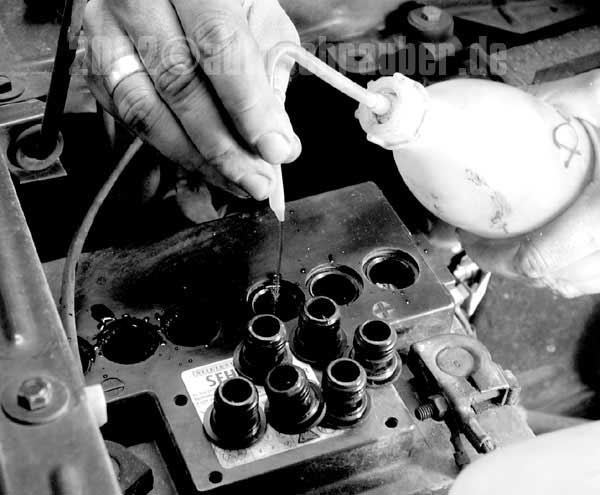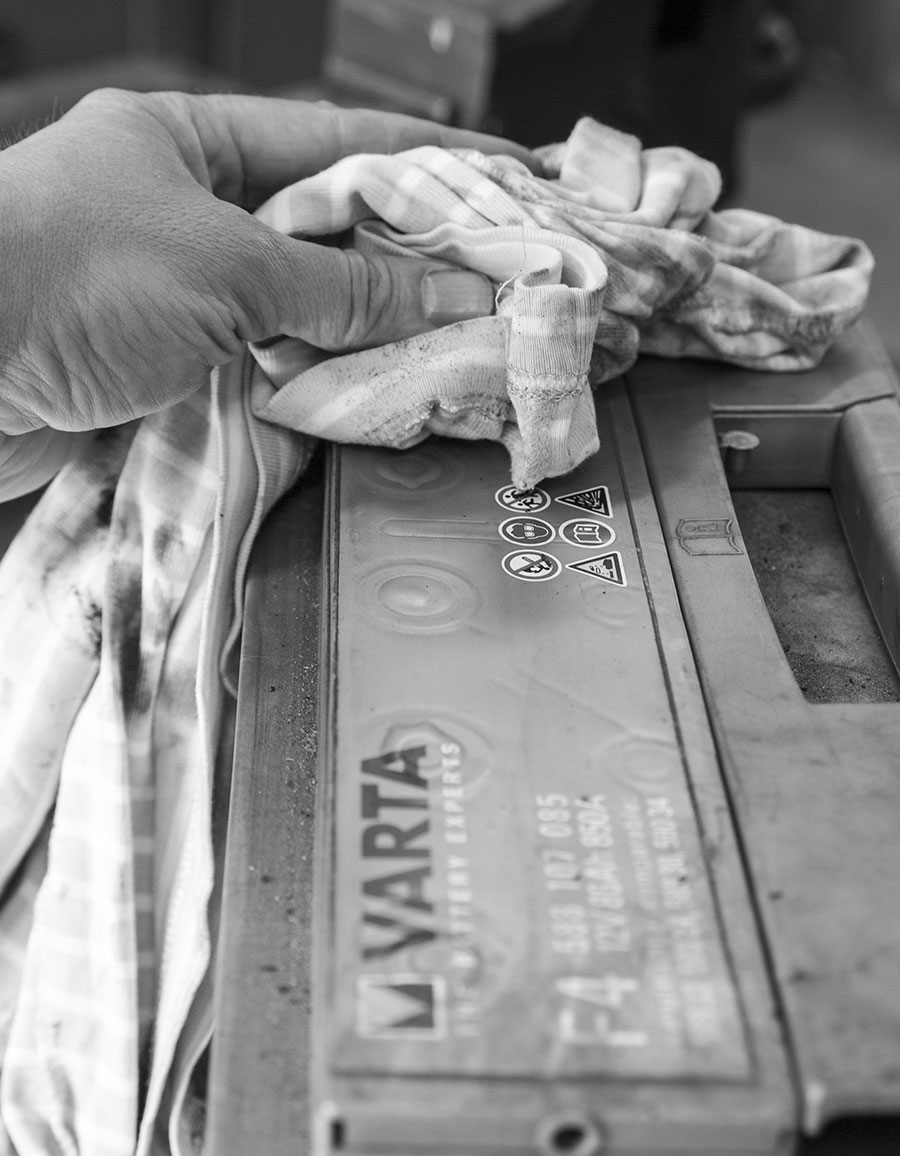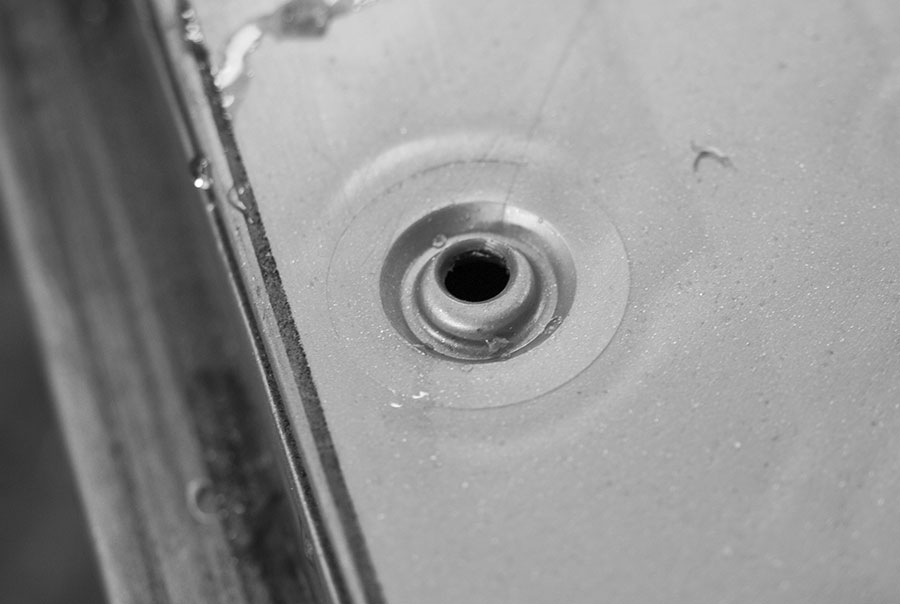Lead-acid or AGM?
Lead-acid batteries need exactly two things for a long life: sufficient acid in the cell and regular work. Nothing more.
These laws, which have been in force since the conquest of Carthage by the Romans, usually help even Chinese batteries to achieve a service life of 10 or even 12 years – with minimal maintenance.
It is understandable that this replacement interval almost causes physical pain to the business administrator responsible for spare parts; after all, the battery could outlive the vehicle.
The solution to this untenable situation is the “maintenance-free battery” according to DIN. It differs from the lead block, which has remained unchanged since Robert Bosch, only in the lack of a plug for refilling water. Because of this shortcoming, it is not possible to top up the water here – and the battery is left to die of thirst. As a result, such power storage units often die after just 4 years, i.e. in line with business plans, and are then replaced (ideally in a brand workshop) with a hellishly expensive new part.
Our article shows the rescue of such a thirsty battery by drilling exactly 6 holes.
The following instructions only refer to lead-acid batteries. In AGM batteries, the electrolyte is trapped in a fleece between the plates. There’s nothing to repair here. If you are not sure, remove the thing and shake it. If it gurgles inside, you have a lead-acid battery on your lap.
Long life with water
Diluted sulphuric acid in the usually 6 battery cells is the lifeblood of every starter battery. Depending on the state of charge of the cells, their acid density fluctuates during charging and discharging; at the same time, a certain amount of water constantly evaporates or is decomposed by electrolysis.
The amount of water loss depends on the operating temperature and the “electrical load” on the battery. It’s easy to guess that MORE water is lost at higher temperatures than at lower ones.
In line with the spare parts department, the battery is therefore installed in a place that gets around 60 °C during normal vehicle operation. This heats up the evaporation and quickly causes the acid level to fall below the upper edge of the lead plates.
As a result, the plates and grilles crumble virtually in fast motion and reduce the service life to a level that is conducive to the spare parts industry.
In the case of “low-maintenance batteries”, i.e. the good old batteries with plugs, they were unscrewed every time the oil was changed and the water that had escaped was added – and the long life was guaranteed.

Labyrinth instead of plugs
6 plugs saved (for a 12-volt battery) elevate the lead block from “low-maintenance” to “maintenance-free” and generally make it 20 Dollars more expensive.
To prevent the thing from exploding when the alternator pumps full power into the battery, the plugless model has a tiny labyrinth in the plug or its own “vent”. This can be observed on motorcycle batteries – here a small PVC hose leads the exhaled water and oxyhydrogen gas somewhere into the rear of the bike.
This pressure relief is vital because not only water is lost during charging and discharging, but oxygen and water are also electrolyzed. We all know this from physics lessons – because this oxyhydrogen mixture has very wide ignition limits and considerable explosive power, the smart man always wears safety goggles when working on batteries and puts the fag out outside.
The economist-friendly battery hidden behind the Iphone-controlled make-up mirror also has such a labyrinth built in; usually recognizable by the encapsulated plastic cover of the battery.

Long life, professionally shortened
There are two main methods for killing lead-acid batteries: deep discharging and boiling to death.
In the first method, the incorrectly configured Tamagotchi charging cradle drains the battery over the summer vacation and causes the plates inside the lead block to sulphate.
With method two, the alternator supplies too high a charging voltage to the already full battery. High battery temperatures favor the process and turn the battery into a gas factory.
It spits the electrolyte drop by drop into the labyrinth or out of the vent. This is usually caused by a defective generator regulator or the battery being installed in the wrong place.
Long life: Use the battery!
Eternal battery life with enough acid and charge? If so, you could put the new battery, pumped full to the brim with acid and energy, in a dark room and wait. To prevent self-discharging, fit the expensive super special electronic charger and then turn the ignition key after 3 years. Well?
It’s easy to guess what happens: Nothing. The battery is dead, although all 17 bars on the charger display were green. This is because the super special nose hair trimmers from the accessory trade does not prevent what experts call “stratification” in the battery. After all, thick acid is heavier than thin acid and sinks to the bottom where it eats away at the plates. A battery that is not moved mechanically will therefore disintegrate simply by standing around.
Expensive lead-acid batteries for emergency power supply are therefore suspended in special swings and regularly rocked back and forth like a small diaper stinker to mix the electrolyte. Alternatively, you can install magnetic stirrers to keep the acid in motion.
In cars and motorcycles, the vehicle takes on this honorable and useful task: even the 2-kilometer shopping trip to the liquor store on Saturdays is enough to reliably prevent stratification. The bottom line is that you simply have to leave your battery installed and use it from time to time.
Battery broken?
So if, when you turn the ignition key in the morning, only the christmans tree lights up and the starter motor won’t start, the diagnosis “dead battery” is often not wrong.
Especially if the beloved car has only been on the road for four or five years and the mishap didn’t happen at the first frost.
Fortunately, it is relatively easy to give the poor thing the vital cola can full of water again.
In principle, this is possible with the battery installed; we have lifted the somewhat older lead block from an old Mercedes on the welding table of the Autoschrauber.de laboratory in a photo-ready manner.
Security is a must
We’ve already had it: oxyhydrogen and acid.
The former has enormous explosive power, even in doses as small as a cubic centimeter, and shatters the plastic casing of the battery into millimeter-sized splinters that crash into the workshop wall and the conjunctiva of the astonished observer.
To increase the damage, points one and two can be combined: Usually only used by the offended Mohammedan for acid attacks, the battery acid spreads effortlessly and automatically throughout the building during the detonation of the oxyhydrogen gas.
So to ensure that man and workshop don’t look like a recaptured village in eastern Ukraine, keep ignition sources away, wear safety goggles and always know where the nearest tap is. Or the next rain barrel. And then, in an emergency, push the head under or in there.
Only then and only then should you start handling the battery (on an acid-resistant surface).

Cell research
So heave the lead block onto the workbench.
Bulges under the top sticker usually reveal where the 6 cells and filler openings of the battery are located. Pop off the stickers.
In principle, it does not matter where you drill into the cell to top up with distilled water.
However, the cells are all connected with a lead bridge to create the battery. And the location of these bridge elements can rarely be guessed from the outside. The borehole is therefore ideal where there is definitely a clear path: In and through the labyrinth. This also works just as well or just as badly after the battery has been saved, so that although a hole does harm, the benefits clearly outweigh the disadvantages.
Fortunately, the plastic is (still!) made of non-conductive material, so that drilling chips can fall into the cell without causing problems. Carefully drill out with a 4 or 5 millimeter twist drill and then countersink the hole slightly.




Letzte Aktualisierung am 2024-04-05 / Affiliate Links / Bilder von der Amazon Product Advertising API
Water the thirsty
If you look through the small hole (with safety goggles!), you realize that there is no water and therefore no starting current.
A squirt bottle from the laboratory accessories is ideal for the professional irrigation of the battery cell.
Fill with enough distilled water to cover the plate set by at least one centimeter.
Is it necessary to point out that the water must be distilled? Nowadays available at discount stores. Costs nothing.


Cell closure
Sealing the repaired cells requires full creativity and an imaginative choice of materials. Because this battery took a good 7 years to reach the dry spell, a temporary filling with windshield sealant did a good job. Acrylic sealant, Dirko or all other hardening and non-hardening sealants are also possible.
In case of doubt, the stuff should fly out if the labyrinth fails in the worst-case scenario and excess pressure builds up in the cell.
Small plugs, for example from an old motorcycle battery, are also conceivable – power donors retrofitted in this way can then be serviced regularly like a “normal” battery and have a long and longer life. Incidentally, “Resurrection” is the title of a very readable novel by the ardent car mechanic Leo Tolstoy. 628 edifying pages, which even pay for themselfes in a gilt-edged edition with a single repaired battery.

Letzte Aktualisierung am 2024-04-05 / Affiliate Links / Bilder von der Amazon Product Advertising API









